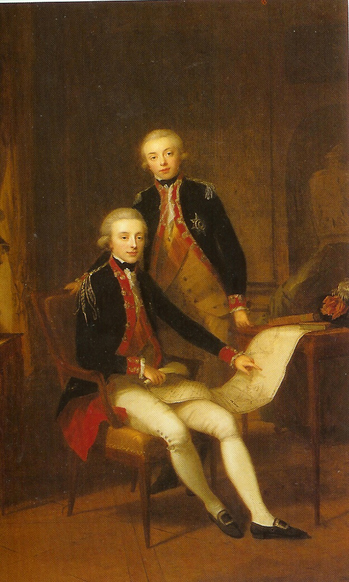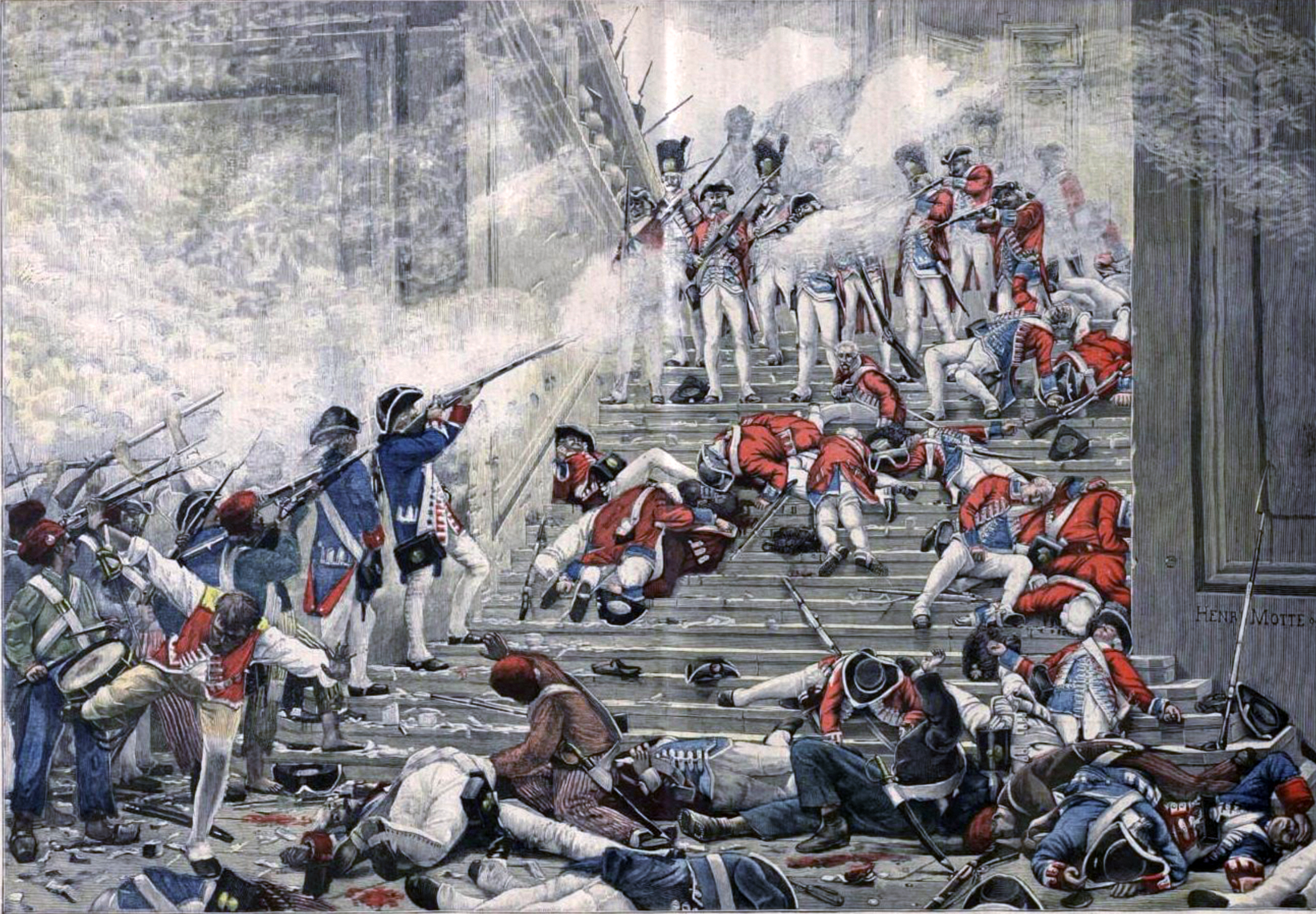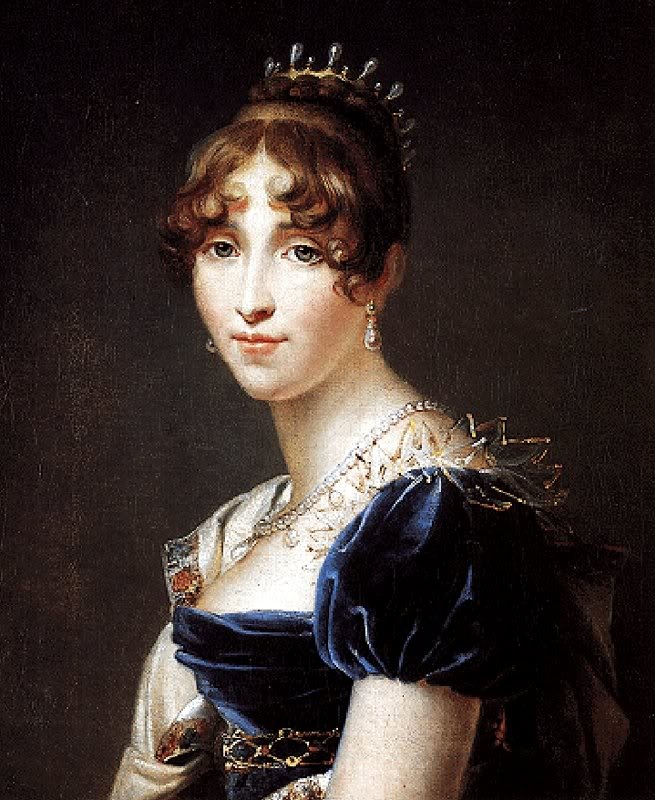|
Henrietta D'Oultremont
Countess Henriëtte Adriana Maria Ludovica Flora d'Oultremont de Wégimont (28 February 1792 in Maastricht–26 October 1864 at Rahe Castle in Aachen) was the second, morganatic, wife of the first Dutch king, William I. Being the morganatic wife of the King, she was never made Queen Consort. Life Henriëtte d'Oultremont was one of five children of Count Ferdinand d'Oultremont de Wégimont (1760-1799) from Liège and his wife, Johanna Susanna Hartsinck (1759-1830), daughter of Admiral Andries Hartsinck (1720-1788) and Johanna Cornelia de Bas (1721-1787). She was related to Count Charles Jean "John" d'Oultremont (1848-1917). Around 1840, King William found himself in discord with much of the Dutch population due to his refusal to implement demanded reforms. This discord was enhanced when the king, head of the strictly Protestant and royal House of Orange-Nassau, announced his intention to marry the Catholic Countess Henriëtte, who had been a lady-in-waiting to his first ... [...More Info...] [...Related Items...] OR: [Wikipedia] [Google] [Baidu] |
William I Of The Netherlands
William I (Willem Frederik; 24 August 1772 – 12 December 1843) was King of the Netherlands and List of monarchs of Luxembourg, Grand Duke of Luxembourg from 1815 until his abdication in 1840. Born as the son of William V, Prince of Orange, the last stadtholder of the Dutch Republic, and Wilhelmina of Prussia, Princess of Orange, Wilhelmina of Prussia, William experienced significant political upheavals early in life. He fought against the French invasion during the Low Countries theatre of the War of the First Coalition, Flanders campaign, and after the Batavian Revolution in 1795, his family went into exile. He briefly ruled the Principality of Nassau-Orange-Fulda before Napoleon's French troops' occupation forced him out of power. Following the defeat of Napoleon in 1814, William was invited back to the Netherlands, where he proclaimed himself Sovereign Prince of the United Netherlands. In 1815, William raised the Netherlands to a kingdom and concurrently became the gran ... [...More Info...] [...Related Items...] OR: [Wikipedia] [Google] [Baidu] |
William II Of The Netherlands
William II (; English: William Frederick George Louis; 6 December 1792 – 17 March 1849), known as Koning Willem de Tweede or Koning Willem II in the Netherlands, was King of the Netherlands, Grand Duke of Luxembourg, and Duke of Limburg. William II was the son of William I and Wilhelmine of Prussia. When his father, who up to that time ruled as sovereign prince, proclaimed himself king in 1815, he became Prince of Orange as heir apparent of the United Kingdom of the Netherlands. With the abdication of his father on 7 October 1840, William II became king. During his reign, the Netherlands became a parliamentary democracy with the new constitution of 1848. William II was married to Anna Pavlovna of Russia. They had four sons and one daughter. William II was succeeded by his son William III. Early life and education Willem Frederik George Lodewijk was born on 6 December 1792 in The Hague. He was the eldest son of the then Prince William and Wilhelmine of Prussia. His mat ... [...More Info...] [...Related Items...] OR: [Wikipedia] [Google] [Baidu] |
People From Maastricht
The term "the people" refers to the public or common mass of people of a polity. As such it is a concept of human rights law, international law as well as constitutional law, particularly used for claims of popular sovereignty. In contrast, a people is any plurality of persons considered as a whole. Used in politics and law, the term "a people" refers to the collective or community of an ethnic group or nation. Concepts Legal Chapter One, Article One of the Charter of the United Nations states that "peoples" have the right to self-determination. Though the mere status as peoples and the right to self-determination, as for example in the case of Indigenous peoples (''peoples'', as in all groups of indigenous people, not merely all indigenous persons as in ''indigenous people''), does not automatically provide for independent sovereignty and therefore secession. Indeed, judge Ivor Jennings identified the inherent problems in the right of "peoples" to self-determination, as i ... [...More Info...] [...Related Items...] OR: [Wikipedia] [Google] [Baidu] |
19th-century Dutch People
The 19th century began on 1 January 1801 (represented by the Roman numerals MDCCCI), and ended on 31 December 1900 (MCM). It was the 9th century of the 2nd millennium. It was characterized by vast social upheaval. Slavery was abolished in much of Europe and the Americas. The First Industrial Revolution, though it began in the late 18th century, expanded beyond its British homeland for the first time during the 19th century, particularly remaking the economies and societies of the Low Countries, France, the Rhineland, Northern Italy, and the Northeastern United States. A few decades later, the Second Industrial Revolution led to ever more massive urbanization and much higher levels of productivity, profit, and prosperity, a pattern that continued into the 20th century. The Catholic Church, in response to the growing influence and power of modernism, secularism and materialism, formed the First Vatican Council in the late 19th century to deal with such problems and confirm ce ... [...More Info...] [...Related Items...] OR: [Wikipedia] [Google] [Baidu] |
Morganatic Spouses
Morganatic marriage, sometimes called a left-handed marriage, is a marriage between people of unequal social rank, which in the context of royal family, royalty or other List of titles, inherited title prevents the principal's position or privileges being passed to the spouse, or any children born of the marriage. The concept is most prevalent in German-speaking territories and countries most influenced by the customs of the German-speaking realms. Generally, this is a marriage between a man of high birth (such as from a reigning, abolished monarchy, deposed or German mediatisation, mediatised dynasty) and a woman of lesser status (such as a daughter of a German nobility#Divisions of nobility, low-ranked noble family or a commoner).Webster's Online Dictionary . Retrieved 2008-07-10.Ghislain de Diesbach, Di ... [...More Info...] [...Related Items...] OR: [Wikipedia] [Google] [Baidu] |
1864 Deaths
Events January * January 13 – American songwriter Stephen Foster (" Oh! Susanna", " Old Folks at Home") dies aged 37 in New York City, leaving a scrap of paper reading "Dear friends and gentle hearts". His parlor song " Beautiful Dreamer" is published in March. * January 16 – Denmark rejects an Austrian-Prussian ultimatum to repeal the Danish Constitution, which says that Schleswig-Holstein is part of Denmark. * January 21 – New Zealand Wars: The Tauranga campaign begins. February * February – John Wisden publishes '' The Cricketer's Almanack for the year 1864'' in England; it will go on to become the major annual cricket reference publication. * February 1 – Danish-Prussian War ( Second Schleswig War): 57,000 Austrian and Prussian troops cross the Eider River into Denmark. * February 15 – Heineken Brewery is founded in the Netherlands. *American Civil War: ** February 17 – The tiny Confederate hand-propelled subma ... [...More Info...] [...Related Items...] OR: [Wikipedia] [Google] [Baidu] |
1792 Births
Events January–March * January 9 – The Treaty of Jassy ends the Russian Empire's war with the Ottoman Empire over Crimea. * January 25 – The London Corresponding Society is founded. * February 18 – Thomas Holcroft produces the comedy ''The Road to Ruin (play), The Road to Ruin'' in London. * February 20 ** The Postal Service Act, establishing the United States Postal Service, United States Post Office Department, is signed by President George Washington.''Harper's Encyclopaedia of United States History from 458 A. D. to 1909'', ed. by Benson John Lossing and, Woodrow Wilson (Harper & Brothers, 1910) p169 ** Parliament House, Dublin catches fire during a legislative session. "Although in imminent danger of the roof falling in," it is noted later, "the House did not adjourn until a proper motion had been put and carried in the affirmative.""Fires, Great", in ''The Insurance Cyclopeadia: Being an Historical Treasury of Events and Circumstances Connect ... [...More Info...] [...Related Items...] OR: [Wikipedia] [Google] [Baidu] |
List Of Dutch Consorts
In the Netherlands, a royal consort is a person married to the Dutch monarch during his or her reign. All female spouses of the monarchs of the Netherlands have been titled "Queen consort, Queen of the Netherlands" with the style ''Majesty''. The male spouses of the three queens regnant of the Netherlands were titled "Prince of the Netherlands" with the style ''Royal Highness''. The spouse of the Bonaparte King of Holland was "Queen consort, Queen of Holland" with the style ''Majesty''. The following spouses of the monarchs of Holland between 1806 and 1810; and the Netherlands since 1813: Queens consort of Holland Royal consorts of the Netherlands See also *Princess of Orange *List of consorts of Luxembourg *Duchess of Limburg *List of Belgian consorts *Duchess of Brabant *Countess of Flanders *Countess of Hainaut *Countess of Holland *Countess of Artois *List of Burgundian consorts *List of consorts of Lorraine *Countess of Zutphen *List of monarchs of the Netherlands Not ... [...More Info...] [...Related Items...] OR: [Wikipedia] [Google] [Baidu] |
List Of Dutch Monarchs
This is a list of monarchs of the Netherlands (Dutch language, Dutch: ''Koningen der Nederlanden''). By practical extension, the list includes the stadtholders of the House of Orange Nassau since 1556. However, they were voted into office by, and were civil servants and generals of, the semi-independent provinces of the Dutch Republic and cannot be seen as monarchs. From William IV, Prince of Orange, William IV they were the direct male line ancestors of later monarchs when the Monarchy of the Netherlands, monarchy was established in 1813 (first as a Sovereign Principality, but in 1815 as a Kingdom). Dutch Republic (1581–1795) The origin of the Dutch monarchy can be traced back to the appointment of William the Silent, William I, Prince of Orange as stadtholder of County of Holland, Holland, Zeeland and Utrecht (province), Utrecht in 1559 by Philip II of Spain. However, he was removed from office and became the leader of the Dutch Revolt. Consequently, the States-General of ... [...More Info...] [...Related Items...] OR: [Wikipedia] [Google] [Baidu] |
Delft
Delft () is a List of cities in the Netherlands by province, city and Municipalities of the Netherlands, municipality in the Provinces of the Netherlands, province of South Holland, Netherlands. It is located between Rotterdam, to the southeast, and The Hague, to the northwest. Together with them, it is a part of both the Rotterdam–The Hague metropolitan area and the Randstad. Delft is a popular tourist destination in the Netherlands, famous for its historical connections with the reigning House of Orange-Nassau, for its Delftware, blue pottery, for being home to the painter Johannes Vermeer, Jan Vermeer, and for hosting Delft University of Technology (TU Delft). Historically, Delft played a highly influential role in the Dutch Golden Age. In terms of science and technology, thanks to the pioneering contributions of Antonie van Leeuwenhoek and Martinus Beijerinck, Delft can be considered to be the birthplace of microbiology. History Early history The city of Delft came int ... [...More Info...] [...Related Items...] OR: [Wikipedia] [Google] [Baidu] |
Nieuwe Kerk (Delft)
The Nieuwe Kerk (; ) is a Protestant church in the city of Delft in the Netherlands. The building is located on Delft Market Square (Markt), opposite to the City Hall (Dutch: ''Stadhuis''). In 1584, William the Silent was entombed here in a mausoleum designed by Hendrick and Pieter de Keyser. Since then, members of the House of Orange-Nassau have been entombed in the royal crypt. The latest members to have been entombed are Queen Juliana and her husband Prince Bernhard in 2004. The private royal family crypt is not open to the public. The church tower, with the most recent recreation of the spire, was designed by Pierre Cuypers and completed in 1872. It is the second highest in the Netherlands, after the Domtoren in Utrecht. History The New Church, formerly the church of St. Ursula (14th century), is the burial place of the princes of Orange. The church is remarkable for its fine tower and chime of bells, containing the splendid allegorical monument of William the Silent. It ... [...More Info...] [...Related Items...] OR: [Wikipedia] [Google] [Baidu] |
Berlin
Berlin ( ; ) is the Capital of Germany, capital and largest city of Germany, by both area and List of cities in Germany by population, population. With 3.7 million inhabitants, it has the List of cities in the European Union by population within city limits, highest population within its city limits of any city in the European Union. The city is also one of the states of Germany, being the List of German states by area, third smallest state in the country by area. Berlin is surrounded by the state of Brandenburg, and Brandenburg's capital Potsdam is nearby. The urban area of Berlin has a population of over 4.6 million and is therefore the most populous urban area in Germany. The Berlin/Brandenburg Metropolitan Region, Berlin-Brandenburg capital region has around 6.2 million inhabitants and is Germany's second-largest metropolitan region after the Rhine-Ruhr region, as well as the List of EU metropolitan areas by GDP, fifth-biggest metropolitan region by GDP in the European Union. ... [...More Info...] [...Related Items...] OR: [Wikipedia] [Google] [Baidu] |








